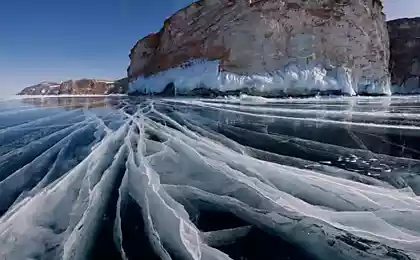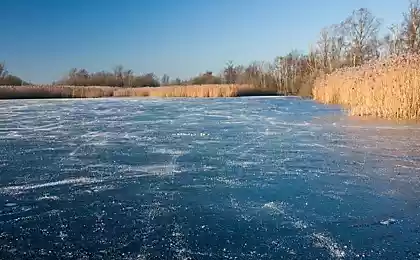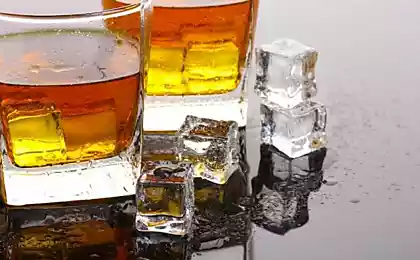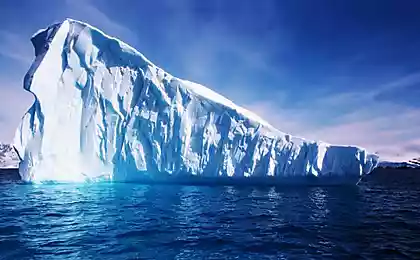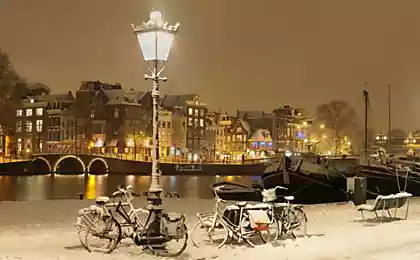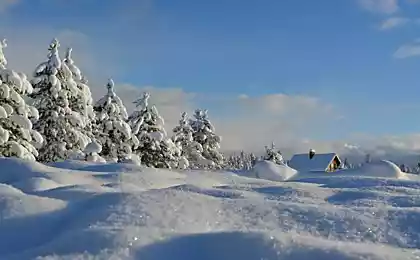2077
Ice world (26 photos)
At a certain time of year, ice formations can be seen in different regions of the cold.
This beauty is not available to many, mainly scientists and the few adventurers who do not stop the significant physical and financial costs.
This beauty is worth it.
1. Blue River, Greenland
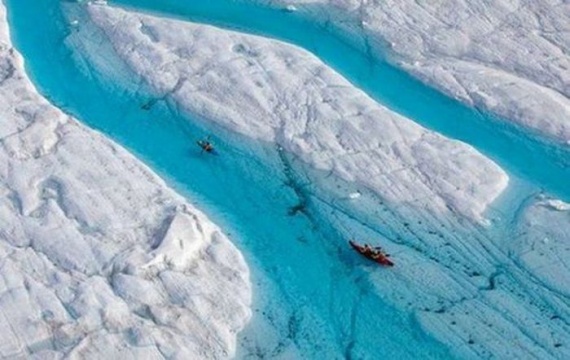
This river is a paradise for Greenland kayaking. Petermann glacier meltwater (Petermann) fill low-lying regions of the stunning blue water.
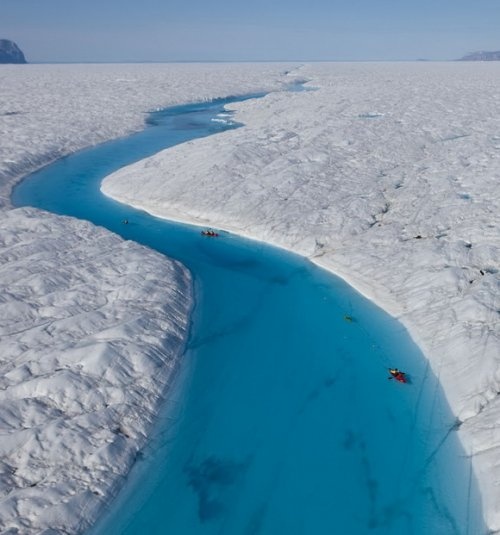
The river changes its form every season, depending on changes in the flow of meltwater. The bright blue color of the river caused by glacial silt.
2. Glacial waterfalls on Spitsbergen (Svalbard), Norway
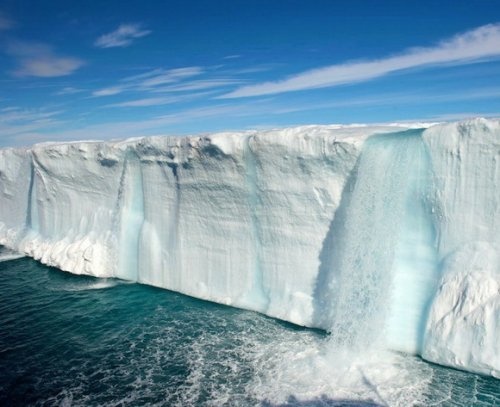
The name Svalbard (Spitzbergen second name), a Norwegian means "cold shores". Svalbard is an archipelago in the Arctic in the north of Norway and Europe. It is located about 650 kilometers north of mainland Europe, midway between mainland Norway and the North Pole. Despite its close proximity to the North Pole, Svalbard is relatively warm, thanks to the warming effect of the Gulf Stream, which makes it suitable for housing. Generally, Svalbard is the northernmost inhabited region of the planet.
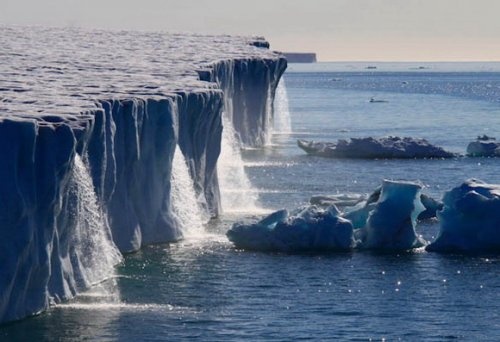
Svalbard Islands occupy a total area of 62,050 square kilometers, about 60% of which is covered by glaciers, the edges of which go deep into the sea. Giant glacier Bråsvellbreen (Bråsvellbreen), located on the second largest island in the archipelago called North East Land (Nordaustlandet), stretches for 200 kilometers. From 15-20 meters high ice edge of the ice fall hundreds of waterfalls of meltwater. These waterfalls can be seen only in the warmer months.
3. Crystal Cave, Iceland
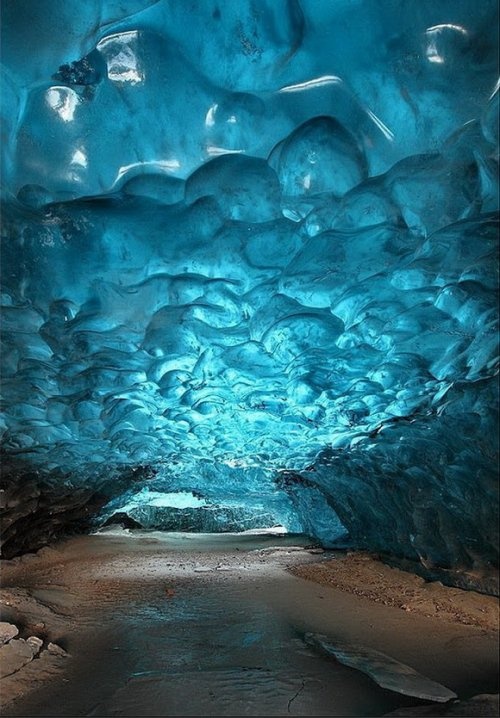
This cave in the glacier ice, formed as a result of glacier mills or stranded cotton thread. This phenomenon occurs when rain and melt water from the glacier surface is formed in the streams and flows under the glacier through its cracks. Falls caves in the glacier and collected water flows down to lower altitudes, forming a long ice cave with a yield generated on the edge of the glacier.

Fine-grained, and wind-borne sediments give the dingy color of frozen streams once the melt water, while the top of the cave has a dark blue color. Due to the rapid movement of ice on the bumpy terrain of about 1 meter per day, this ice cave was split at the end, forming a deep vertical slit. This allows non-directional sunlight get into the cave from both of its sides, providing an ice tunnel steady light.
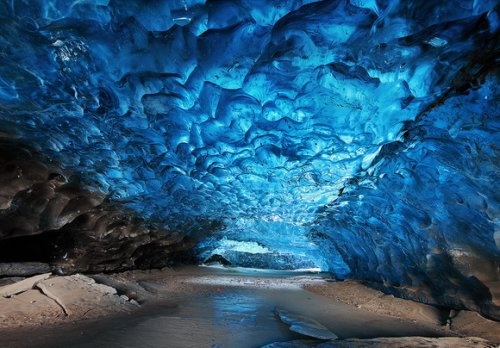
The cave can be accessed from the shore, 7 meter hole. The tunnel is gradually narrowed, and at the end of its height is no more than 1, 2 meters. Ice Caves in general are unstable and can collapse at any moment. They are safe to visit only in winter, when cold temperatures much frozen ice. The cave is constantly heard crackling sounds. They heard not because the cave is about to come crashing down, but from the fact that the cave moves with the glacier itself. Every time the glacier moves a millimeter - can be heard loud noises.
4. Briksdalsbreen Glacier (Briksdalsbreen), Norway
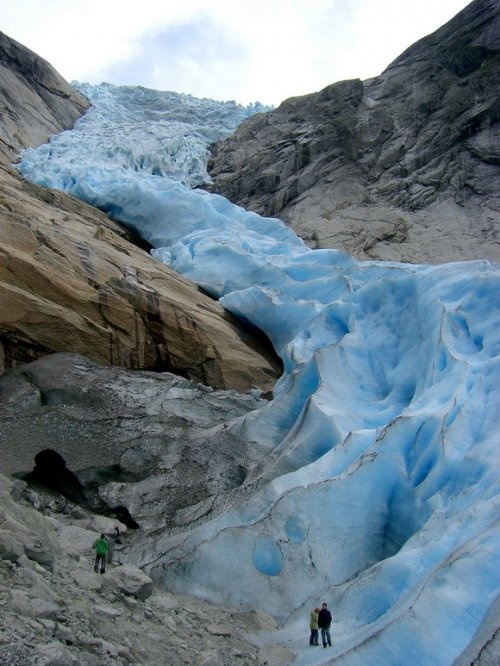
Briksdalsbreen glacier is one of the most accessible and the most famous slopes of the glacier Jostedalsbreen (Jostedalsbreen). It is located in Norway and is part of the National Park Jostedalsbreen. Briksdalsbreen ends with a small glacial lake Briksdal (Briksdalsbrevatnet), which is located in 346 meters above sea level.
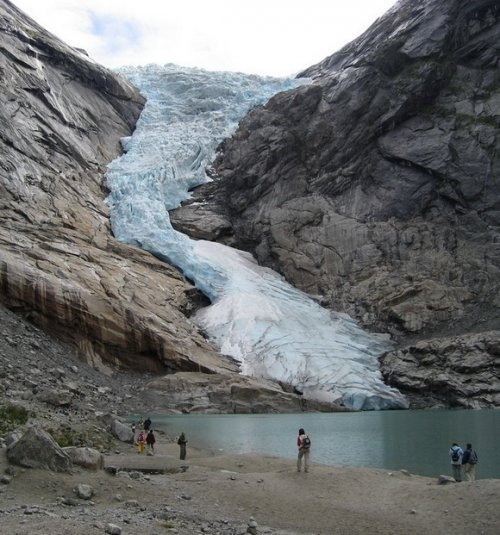
Tourists from all over the world come to see the beautiful glacier Briksdalsbreen, so majestically set amongst waterfalls and high peaks.
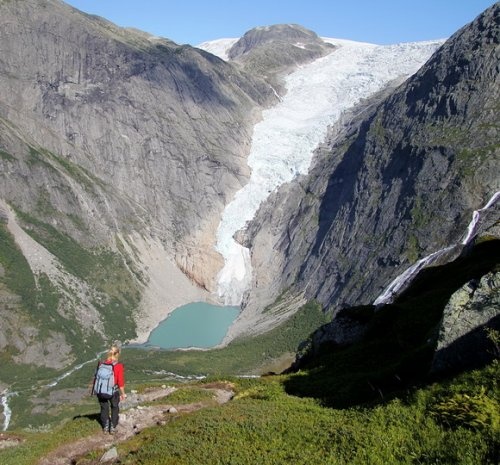
Wearing proper equipment, and carefully fulfilling all the recommendations of the instructor, visitors can take part in a completely safe, but incredibly fascinating journey through the millennial ice mass.
5. Ice Canyon (Birthday Canyon), Greenland

Ice depth of the canyon formed by melt water is 45 meters. This photo was taken in 2008. The lines on his walls, located on the edge of the canyon, show the stratigraphic layers of ice and snow, which were postponed for many years.
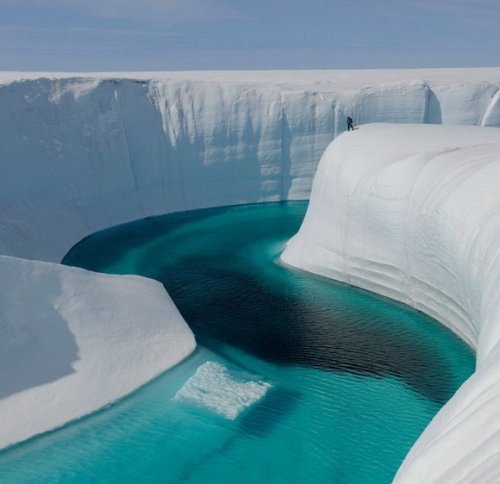
Leuinter Adam (Adam LeWinter) stands on the edge of the Ice Canyon, on a ledge called "Moab» (Moab). Black deposits at the bottom of the channel is the cosmic dust - fine dust to be applied by the wind, which settles and accumulates in the snow on the glaciers or ice caps.
6. Glacier "Elephant foot» (Elephant-Foot Glacier), Greenland
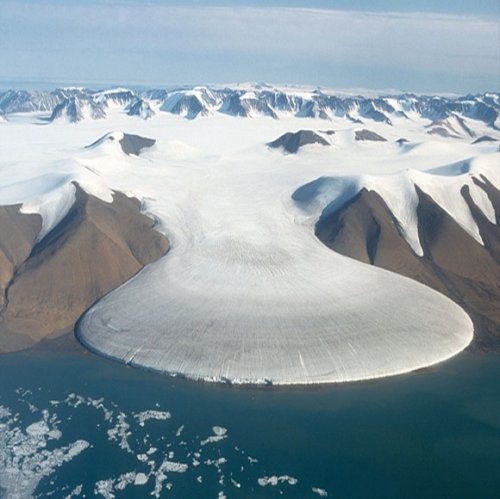
Arctic Glacier "elephant foot" is located in the north of Greenland. The northern zone, the bottom of the glacier is the ablation zone, dissected streams of meltwater. It is clearly different in color from pure white surface of the upper zone where snow accumulates.
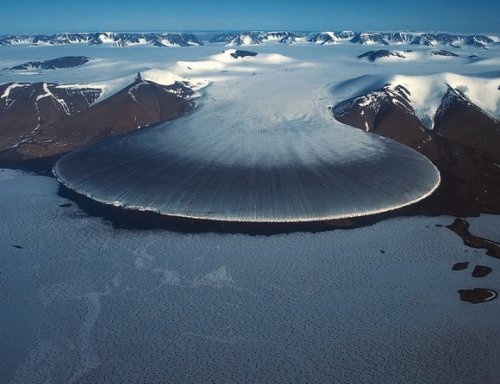
This unique glacier takes amazing geographical position in the north-east coast of Greenland (81 ° N).
7. Frozen Wave (Frozen Wave), Antarctica
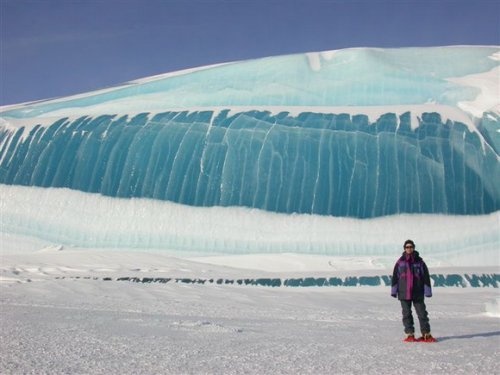
This unique wave is frozen in Antarctica. She was discovered by American scientists Travuylonom Tony (Tony Travouillon) in 2007.
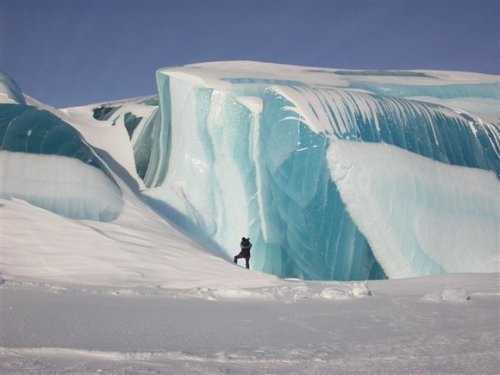
These photos are not captured giant wave, somehow frozen in a moment. This formation consists of blue ice that is convincing evidence that it was not the wave of water.
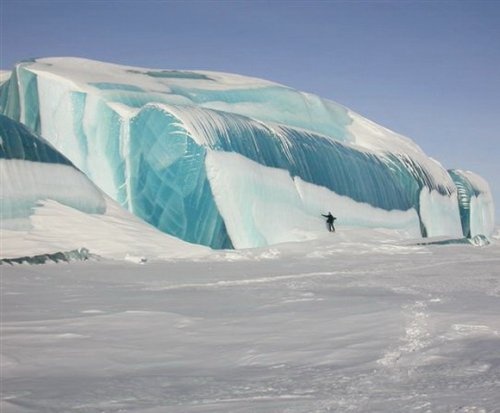
Blue ice formed during compression release the frozen ice and air bubbles. Ice looks blue because, when light passes through the thick ice, the blue light is reflected and red light is absorbed.

Thus, a dark blue color indicates that the ice formed over a long period of time rather than instantaneously. Subsequent melting and re-freezing for many seasons have given this education sleek look, reminiscent of the wave.
8. Striped Icebergs (Striped Icebergs), the Southern Ocean
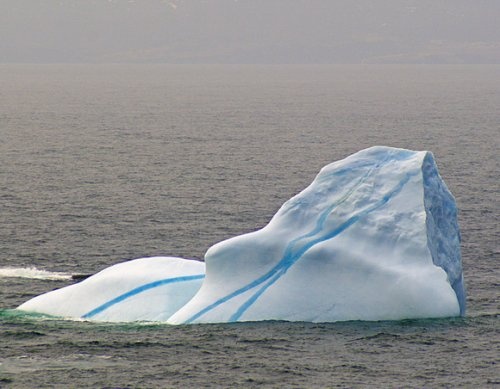
Most often, icebergs have a blue and green stripes, but sometimes you can meet and brown stripes. This phenomenon is common in the Southern Ocean. Striped Icebergs with multiple colored stripes, including yellow, brown, black and blue, are quite common in the cold waters around Antarctica. Icebergs are formed when large pieces of ice break off from the ice shelf and fell into the sea.
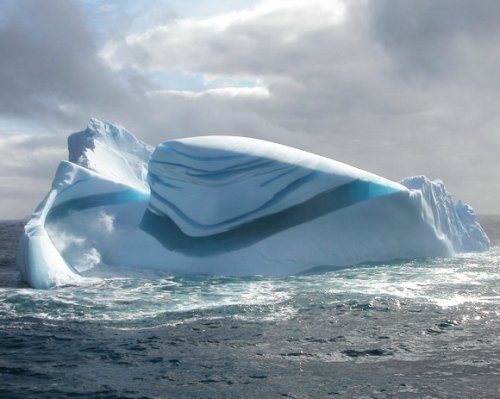
Due to the fact that glaciers are formed due to the snow falling on Antarctica thousands of years, the glacial ice is made up of fresh water. Thus, it turns out that the floating ice interacts with fresh salt water. Sea water in turn freezes on contact with superholodnym glacier covering its crust. The upper layer was ice formed sea water contains organic matter and minerals. Washed by waves and blown by the wind, striking glaciers paint the colored stripes of varying shapes and textures.
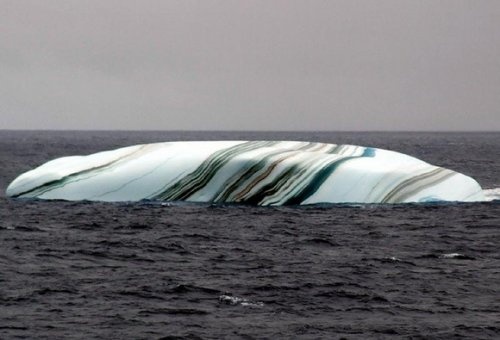
Iceberg looks white because of tiny bubbles immured in ice, and due to light scattering. Blue stripes are formed when a crack in the ice sheet is filled with meltwater and freezes quickly. In this case, the bubbles could not be formed. When the water is rich in algae, stripes painted in green and many other shades.
9. Icy Tower of Mount Erebus, Antarctica

Hundreds of ice spiers towers located on Mount Erebus (height of 3800 meters above sea level) look like a one-day stubble on his face giant. Constantly active volcano, perhaps the only place in Antarctica, where fire and ice meet, interact and create something unique covering both their nature.
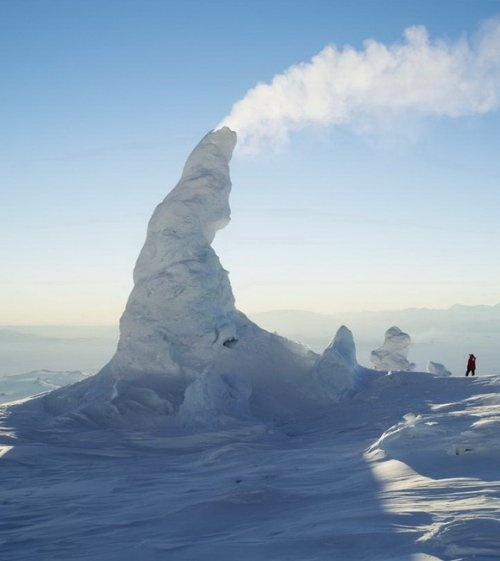
The towers can reach up to 20 meters in height and look almost alive as they produce jets of steam to the southern polar heavens. Part of volcanic vapor freezes on the inner parts of the towers, and increasing their breadth and height.
10. "Fang" - Frozen waterfall in Vail (The Fang in Vail - Frozen Waterfall), US

"Fang" is a waterfall located near the town of Vail, Colorado. A huge column of ice formed from this waterfall only during unusually cold winters, and when that happens, the column height is about 50 meters in height and the width of its base has 8 meters.
11. Kalgaspory (Penitentes), Chile and Argentina
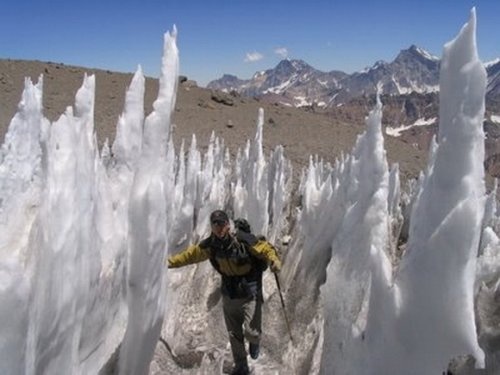
Kalgaspory this amazing ice spikes, formed naturally in the high plains located in the Andean region, which rises more than 4,000 meters above sea level. These pegs are called ice kalgaspory. They may be of different height from a few centimeters (reminiscent of grass, creeping along the ground) to 5 meters (creating the impression of an ice forest). Their peaks grow toward the sun. Kalgaspory slowly and gradually appear when the snow begins to melt from the first sunlight.
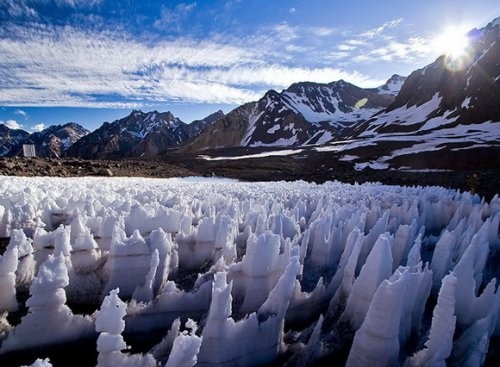
The peoples of the Andes attributed this phenomenon quickly winds blowing in the region, which is in fact the only part of the process. In the wind very limited role in the formation of these beautiful statues. As recent scientific observations: sunlight, feeding on the ice, heats it, in fact, part of the world, ranked in the ice, playing a variety of reflections inside pieces of ice, which leads to non-uniform melting. Well, those of the ice that did not melt, give rise to unusual forms of the statue, known as kalgaspory.
Source: asaratov.livejournal.com
This beauty is not available to many, mainly scientists and the few adventurers who do not stop the significant physical and financial costs.
This beauty is worth it.
1. Blue River, Greenland

This river is a paradise for Greenland kayaking. Petermann glacier meltwater (Petermann) fill low-lying regions of the stunning blue water.

The river changes its form every season, depending on changes in the flow of meltwater. The bright blue color of the river caused by glacial silt.
2. Glacial waterfalls on Spitsbergen (Svalbard), Norway

The name Svalbard (Spitzbergen second name), a Norwegian means "cold shores". Svalbard is an archipelago in the Arctic in the north of Norway and Europe. It is located about 650 kilometers north of mainland Europe, midway between mainland Norway and the North Pole. Despite its close proximity to the North Pole, Svalbard is relatively warm, thanks to the warming effect of the Gulf Stream, which makes it suitable for housing. Generally, Svalbard is the northernmost inhabited region of the planet.

Svalbard Islands occupy a total area of 62,050 square kilometers, about 60% of which is covered by glaciers, the edges of which go deep into the sea. Giant glacier Bråsvellbreen (Bråsvellbreen), located on the second largest island in the archipelago called North East Land (Nordaustlandet), stretches for 200 kilometers. From 15-20 meters high ice edge of the ice fall hundreds of waterfalls of meltwater. These waterfalls can be seen only in the warmer months.
3. Crystal Cave, Iceland

This cave in the glacier ice, formed as a result of glacier mills or stranded cotton thread. This phenomenon occurs when rain and melt water from the glacier surface is formed in the streams and flows under the glacier through its cracks. Falls caves in the glacier and collected water flows down to lower altitudes, forming a long ice cave with a yield generated on the edge of the glacier.

Fine-grained, and wind-borne sediments give the dingy color of frozen streams once the melt water, while the top of the cave has a dark blue color. Due to the rapid movement of ice on the bumpy terrain of about 1 meter per day, this ice cave was split at the end, forming a deep vertical slit. This allows non-directional sunlight get into the cave from both of its sides, providing an ice tunnel steady light.

The cave can be accessed from the shore, 7 meter hole. The tunnel is gradually narrowed, and at the end of its height is no more than 1, 2 meters. Ice Caves in general are unstable and can collapse at any moment. They are safe to visit only in winter, when cold temperatures much frozen ice. The cave is constantly heard crackling sounds. They heard not because the cave is about to come crashing down, but from the fact that the cave moves with the glacier itself. Every time the glacier moves a millimeter - can be heard loud noises.
4. Briksdalsbreen Glacier (Briksdalsbreen), Norway

Briksdalsbreen glacier is one of the most accessible and the most famous slopes of the glacier Jostedalsbreen (Jostedalsbreen). It is located in Norway and is part of the National Park Jostedalsbreen. Briksdalsbreen ends with a small glacial lake Briksdal (Briksdalsbrevatnet), which is located in 346 meters above sea level.

Tourists from all over the world come to see the beautiful glacier Briksdalsbreen, so majestically set amongst waterfalls and high peaks.

Wearing proper equipment, and carefully fulfilling all the recommendations of the instructor, visitors can take part in a completely safe, but incredibly fascinating journey through the millennial ice mass.
5. Ice Canyon (Birthday Canyon), Greenland

Ice depth of the canyon formed by melt water is 45 meters. This photo was taken in 2008. The lines on his walls, located on the edge of the canyon, show the stratigraphic layers of ice and snow, which were postponed for many years.

Leuinter Adam (Adam LeWinter) stands on the edge of the Ice Canyon, on a ledge called "Moab» (Moab). Black deposits at the bottom of the channel is the cosmic dust - fine dust to be applied by the wind, which settles and accumulates in the snow on the glaciers or ice caps.
6. Glacier "Elephant foot» (Elephant-Foot Glacier), Greenland

Arctic Glacier "elephant foot" is located in the north of Greenland. The northern zone, the bottom of the glacier is the ablation zone, dissected streams of meltwater. It is clearly different in color from pure white surface of the upper zone where snow accumulates.

This unique glacier takes amazing geographical position in the north-east coast of Greenland (81 ° N).
7. Frozen Wave (Frozen Wave), Antarctica

This unique wave is frozen in Antarctica. She was discovered by American scientists Travuylonom Tony (Tony Travouillon) in 2007.

These photos are not captured giant wave, somehow frozen in a moment. This formation consists of blue ice that is convincing evidence that it was not the wave of water.

Blue ice formed during compression release the frozen ice and air bubbles. Ice looks blue because, when light passes through the thick ice, the blue light is reflected and red light is absorbed.

Thus, a dark blue color indicates that the ice formed over a long period of time rather than instantaneously. Subsequent melting and re-freezing for many seasons have given this education sleek look, reminiscent of the wave.
8. Striped Icebergs (Striped Icebergs), the Southern Ocean

Most often, icebergs have a blue and green stripes, but sometimes you can meet and brown stripes. This phenomenon is common in the Southern Ocean. Striped Icebergs with multiple colored stripes, including yellow, brown, black and blue, are quite common in the cold waters around Antarctica. Icebergs are formed when large pieces of ice break off from the ice shelf and fell into the sea.

Due to the fact that glaciers are formed due to the snow falling on Antarctica thousands of years, the glacial ice is made up of fresh water. Thus, it turns out that the floating ice interacts with fresh salt water. Sea water in turn freezes on contact with superholodnym glacier covering its crust. The upper layer was ice formed sea water contains organic matter and minerals. Washed by waves and blown by the wind, striking glaciers paint the colored stripes of varying shapes and textures.

Iceberg looks white because of tiny bubbles immured in ice, and due to light scattering. Blue stripes are formed when a crack in the ice sheet is filled with meltwater and freezes quickly. In this case, the bubbles could not be formed. When the water is rich in algae, stripes painted in green and many other shades.
9. Icy Tower of Mount Erebus, Antarctica

Hundreds of ice spiers towers located on Mount Erebus (height of 3800 meters above sea level) look like a one-day stubble on his face giant. Constantly active volcano, perhaps the only place in Antarctica, where fire and ice meet, interact and create something unique covering both their nature.

The towers can reach up to 20 meters in height and look almost alive as they produce jets of steam to the southern polar heavens. Part of volcanic vapor freezes on the inner parts of the towers, and increasing their breadth and height.
10. "Fang" - Frozen waterfall in Vail (The Fang in Vail - Frozen Waterfall), US

"Fang" is a waterfall located near the town of Vail, Colorado. A huge column of ice formed from this waterfall only during unusually cold winters, and when that happens, the column height is about 50 meters in height and the width of its base has 8 meters.
11. Kalgaspory (Penitentes), Chile and Argentina

Kalgaspory this amazing ice spikes, formed naturally in the high plains located in the Andean region, which rises more than 4,000 meters above sea level. These pegs are called ice kalgaspory. They may be of different height from a few centimeters (reminiscent of grass, creeping along the ground) to 5 meters (creating the impression of an ice forest). Their peaks grow toward the sun. Kalgaspory slowly and gradually appear when the snow begins to melt from the first sunlight.

The peoples of the Andes attributed this phenomenon quickly winds blowing in the region, which is in fact the only part of the process. In the wind very limited role in the formation of these beautiful statues. As recent scientific observations: sunlight, feeding on the ice, heats it, in fact, part of the world, ranked in the ice, playing a variety of reflections inside pieces of ice, which leads to non-uniform melting. Well, those of the ice that did not melt, give rise to unusual forms of the statue, known as kalgaspory.
Source: asaratov.livejournal.com

